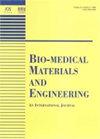使用嵌入活性炭的海藻酸钠-聚乙烯醇水凝胶加强对急性有机磷农药中毒的治疗
IF 1.3
4区 医学
Q4 ENGINEERING, BIOMEDICAL
引用次数: 0
摘要
背景:活性炭吸附是目前临床治疗急性有机磷农药中毒(AOPP)的主要方法。然而,这种方法的吸附时间和效率并不稳定。目的:本研究制备了一种包埋活性炭的水凝胶,并探讨了它对 AOPP 的缓解作用。方法:本研究使用海藻酸钠和聚乙烯醇(SA-PVA)制备了一种复合水凝胶。通过傅立叶变换红外光谱(FTIR)、热重分析(TGA)、X射线衍射(XRD)、扫描电子显微镜(SEM)、拉伸强度和膨胀率等多种分析对 SA-PVA 水凝胶的结构特性进行了表征。在此基础上,将活性炭(AC)嵌入 SA-PVA 水凝胶(SA-PVA-AC)中,用于处理 AOPP。结果:结构表征表明,SA-PVA 水凝胶具有优异的机械性能和生物相容性。体内研究表明,SA-PVA-AC 能明显减轻肝脏的炎症和氧化损伤,这体现在 IL-6、TNF-α、IL-1β、SOD 和 MDA 水平的降低上。此外,SA-PVA-AC 还能有效调节血清 AST 和 ALT 的活性,从而改善肝功能。结论:研究结果表明,嵌入 SA-PVA 水凝胶中的活性炭作为一种治疗剂,在治疗 AOPP 方面具有巨大潜力,并为控制农药引起的毒性提供了一种新方法。本文章由计算机程序翻译,如有差异,请以英文原文为准。
Enhanced treatment of acute organophosphorus pesticide poisoning using activated charcoal-embedded sodium alginate-polyvinyl alcohol hydrogel
BACKGROUND:The adsorption of activated charcoal is currently a major clinical treatment for acute organophosphorus pesticide poisoning (AOPP). However, the adsorption duration and efficiency of this method is unstable. OBJECTIVE:In this study, a hydrogel embedding activated charcoal was prepared and its alleviating effects on AOPP were investigated. METHODS:A composite hydrogel using sodium alginate and polyvinyl alcohol (SA-PVA) hydrogel was prepared in this study. The structural properties of the SA-PVA hydrogel were characterized via multiple analysis including FTIR, TGA, XRD, SEM, tensile strength and expansion rate. Based on these, activated charcoal (AC) was embedded within the SA-PVA hydrogel (SA-PVA-AC) and it was used for the treatment of AOPP. RESULTS:Structural characterization indicated SA-PVA hydrogel possesses excellent mechanical properties and biocompatibility. The in vivo study demonstrated that SA-PVA-AC significantly alleviated the inflammation and oxidative damage in the liver, as evidenced by reduced levels of IL-6, TNF-α, and, IL-1β, SOD, and MDA. Furthermore, SA-PVA-AC treatment effectively re-regulated the activities of serum AST and ALT, exhibiting an improved effect on liver function. CONCLUSION:The findings suggest that activated charcoal embedded within SA-PVA hydrogel has significant potential as a therapeutic agent in treating AOPP, and offering a novel approach to managing pesticide-induced toxicity.
求助全文
通过发布文献求助,成功后即可免费获取论文全文。
去求助
来源期刊

Bio-medical materials and engineering
工程技术-材料科学:生物材料
CiteScore
1.80
自引率
0.00%
发文量
73
审稿时长
6 months
期刊介绍:
The aim of Bio-Medical Materials and Engineering is to promote the welfare of humans and to help them keep healthy. This international journal is an interdisciplinary journal that publishes original research papers, review articles and brief notes on materials and engineering for biological and medical systems. Articles in this peer-reviewed journal cover a wide range of topics, including, but not limited to: Engineering as applied to improving diagnosis, therapy, and prevention of disease and injury, and better substitutes for damaged or disabled human organs; Studies of biomaterial interactions with the human body, bio-compatibility, interfacial and interaction problems; Biomechanical behavior under biological and/or medical conditions; Mechanical and biological properties of membrane biomaterials; Cellular and tissue engineering, physiological, biophysical, biochemical bioengineering aspects; Implant failure fields and degradation of implants. Biomimetics engineering and materials including system analysis as supporter for aged people and as rehabilitation; Bioengineering and materials technology as applied to the decontamination against environmental problems; Biosensors, bioreactors, bioprocess instrumentation and control system; Application to food engineering; Standardization problems on biomaterials and related products; Assessment of reliability and safety of biomedical materials and man-machine systems; and Product liability of biomaterials and related products.
 求助内容:
求助内容: 应助结果提醒方式:
应助结果提醒方式:


